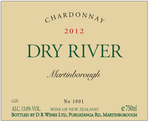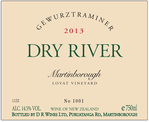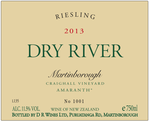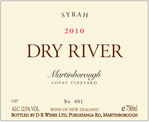
| Dry River vineyard was established in 1979 by Dr Neil and Dawn McCallum. In 2003 the vineyard and winery were sold to Julian Robertson and Reg Oliver with Neil staying at the helm as Chief Winemaker until his retirement in 2011. The name Dry River was that of one of the earliest South Wairarapa sheep stations. Although the vines are planted several kilometres away on the northern boundary of the Martinborough township, Dry River aptly describes the very arid, gravely and free-draining site. The first wines, Chardonnay, Gewurztraminer and Pinot gris were bottled in 1984 and Dry River has since developed a reputation as one of New Zealand’s most iconic pioneering wineries. The vineyards and winery are cared for by a small and dedicated team overseen by Ant Mackenzie, Consultant. In the winery, Wilco Lam is our Chief Winemaker with Thomas Hindmarsh assisting him. Sue Rickey looks after Administration and the vineyards are tended by Nick James, Vineyard Manager, Rob Smith and Michelle Mills. Martinborough terroir: The McCallum’s had been looking for a site for a quality vineyard as early as 1979 and it was clear that Martinborough was the place to investigate. According to friend and soil scientist Dr Derek Milne (later founding partner of Martinborough Vineyard), the virtue of this locality was its 30-year record of the lowest rainfall in the North Island and a heat summation appropriate for growing quality cool-climate varieties such as Pinot noir, Riesling and etc. From the available data, the low rainfall area was limited to a tiny locality roughly 5 km in radius, and a study of soil maps revealed that the deep, free-draining gravels they sought within this were restricted to an even smaller part. By 1986 there were five vineyards and wineries in existence - all planted on the gravels of Martinborough. The pioneers (Ata Rangi, Chifney, Dry River, Martinborough Vineyard and Te Kairanga) decided they would like to define and demarcate the terroir they had adopted, just as such areas are described and mapped in France and Germany, with the expectation that the wines produced from within this area would show similarities reflecting their origin. The crescent-shaped area lay along the edge of the river terrace formed by the Ruamahunga and Huangarua rivers about 20,000 years ago. This is now at the northern side of the township. It was about 1,000ha in total (approximately 600ha was available for planting), and was comprised almost completely of free-draining gravels with the same very low rainfall and similar aspect, temperatures, wind-run and so on, and was therefore felt to be homogenous from a viticultural point of view. From 1986, wines made from within this area were given a seal of origin by the 'Martinborough Winemakers Association', and in 1991 the area was named 'The Martinborough Terrace Appellation' to distinguish it from other types of terroir which were being explored nearby. Authentication of the defined area was administered by the 'Martinborough Terrace Appellation Committee' according to a set of rules and regulations described as 'Martinborough Terrace Appellation of Origin System'. Many hundreds of wines have borne the seal of origin, although nowadays the physical seal tends not to be used, simply because modern labelling machinery cannot easily apply it. No doubt other terroirs will be similarly identified and promoted, and will add to the diversity and quality of wines in the coming years. People did, and still do, affirm there is a particular 'Martinborough style' in wines from this tiny appellation. By 2002 there were around 25 brands originating from the Terrace, with the numbers continuing to increase. The number and variety of quality wines from this tiny area confounds all expectations. Who would have expected world-class Pinot noir, Sauvignon blanc, Riesling, Gewurztraminer, Pinot gris and Syrah to be produced side by side? Martinborough has become an internationally respected wine area and reference to the 'Martinborough Terrace' terroir by winemakers, locals, wine tasters, authors and international commentators persist. Properties within its boundary are greatly sought after. Acknowledgement of this terroir is perceived to have real significance in the understanding of our wine, and for so many it has become a very special place. Philosophy: Dry River's goal is to produce wines of optimal phenolic ripeness with ripe fruit flavours and modest alcohol levels that faithfully reflect the site and vintage. Factors leading to a true expression of the vineyard site include no irrigation, old vines and low crop levels. Cultural management practices in the vineyard that help achieve optimal phenolic ripeness include shoot positioning, leaf plucking and maintenance applications of nutrients. Dry River's approach to winemaking is to preserve rather than enhance. Minimal movements of the young wine, low levels of new oak barrels and a cool cellar environment assist the transition from vineyard to bottle. All wines are bottled at an early stage of evolution and reach their potential under a natural cork closure. The wines tend to be slow to evolve in the bottle but as a result of this, are long-lived. |
| Dry River Website |
 |
| Chardonnay |
| Typical flavours of citrus, white nectarine and hazelnuts are all to the fore, with a nuance of talc and citrus. The winemaking by nature is conservative with gentle oak handling, light lees stirring and a focus on retaining what is good and pure with the wine. This transparency is evident on the palate with the nuances of fruit, oak and lees all making their mark. The focus is always to retain a linearity with Chardonnay but not at the expense of roundness on the mid-palate. This wine is coming from a cooler than average year and should show particularly well with a few years of aging. 13% alcohol. |
 |
| Lovat vineyard - Gewurtztraminer |
| Deep gold with flecks of yellow, the colour of this 2013 Gewurztraminer recalls the golden glow of the sun. Candied fruit aromas of pineapple, mango and tangerine all speak of concentration and purity. A number of picking passes over the season was necessary to capture a wide range of flavours – the later picks are noteworthy in that they contribute amazing 'Bunch Selection' characters of dried apricot and ginger marmalade. The palate continues building from entry to finish – supple and sappy but refined, pure and long to the end. Fruit flavours span the spectrum for Gewurztraminer: lychee, apricot and muscatel. It is difficult to resist the youthful charm of this delicious wine but bottle age will progress the perceived richness and add other nuances of spicy complexity. This process should continue for up to ten years. 14.5% alcohol. 30gr/l RS. |
 |
| Craighall vineyard - Riesling "Amaranth" |
| Like all of Dry River's dry grown vines, the Riesling ones had to endure a very dry season from the start. The vines response to this seasonal environment is to go searching for pockets of moisture, and allocating resources to root growth. This allocation of resources has meant small canopies for the 2013 vintage and therefore low sugar accumulation in the fruit. In the glass the appearance is pale and youthful with a hint of gold. Aromatically there is a mêlée of fruit aromas that include stone fruit, Granny Smith apple and citrus. There is also a further suggestion of honeysuckle and other delicate floral notes on the nose. A citrusy crispness defines the palate with firm acidity. Richness in the form of midpalate weight is all from fruit extract rather than sugar. The mineral nature of this wine, in this case probably from acidity, serves to heighten or magnify the unique character of the Craighall vineyard. Overall this wine is delicate and understated but not without generosity and it should be very long lived in a good cellar. 11.5% alcohol. * The term 'Amaranth' is used for wines that the Dry River's team believe to have an interesting cellaring life ahead. It is not a quality designation and can be used on any of their wines. |
 |
| Lovat vineyard - Syrah |
| Dark ruby with a violet hue. Fresh walnut, marmite and toasty oak overlay an array of red and dark berry notes. Black currant and an ever so slight hint of white pepper dart around on the nose with notes of tar and fresh leather contributing to extra aromatic complexity. Thanks to low cropping levels the palate is dense and weighty, yet soft and buoyant. Upfront flavours of dark fruit are followed by fresh tobacco and Christmas cake spice. The structure grows in strength with well-knitted tannins and considerable length. This is an intricate wine with upfront primary fruit aromas that will develop savory complexity and gain richness over the next five to seven years. 12.5% alcohol. |
| Copyright © 2002-2017 VOS Selections, Inc. |